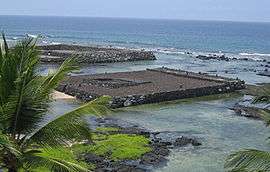Luakini

In ancient Hawaii, a luakini temple, or luakini heiau, was a Native Hawaiian sacred place where human and animal blood sacrifices were offered.
In Hawaiian tradition, luakini heiaus were first established by Paʻao, a legendary priest credited with establishing many of the rites and symbols typical of the stratified high chieftainships of the immediate pre-European-contact period.[1] Modern archaeologists no longer believe in a historic Pa'ao, but many Native Hawaiians still believe that he was a historical figure, and often vilify him for introducing what they now see as the bloody, barbarous rites of the luakini heiau.
List of currently known or reputed luakini heiaus:
- Puʻu O Mahuka, "Hill of Escape"[2]
Maui:
- Puʻukohola National Historic Site[3]
- Moʻokini, birthplace of Kamehameha I[4]
- Aha'ula[1] (now engulfed by lava)
- Keʻeku Heiau on Kahaluʻu Bay[5]
References
- 1 2 "Pa'ao From Thrum, Emerson, and Kamakau". Hawaiian Voyaging Traditions. Retrieved 27 May 2018.
- ↑ Fournier, Rasa. "Hiking Puu O Mahuka Heiau". Hawaii.com. Retrieved 27 May 2018.
- ↑ "Chapter VII: Pu'ukohola Heiau National Historic Site". National Parks Service. Retrieved 29 May 2018.
- ↑ Van James, Ancient Sites of Hawaiʻi, 1995, Mutual Publishing, ISBN 978-1-56647-200-5, page 143
- ↑ "Hoʻihoʻi Kulana Wahi pana - Restoring Sacred Places" (PDF). Kamehameha Investment Corporation. 2008. Retrieved 2009-12-28.
This article is issued from
Wikipedia.
The text is licensed under Creative Commons - Attribution - Sharealike.
Additional terms may apply for the media files.